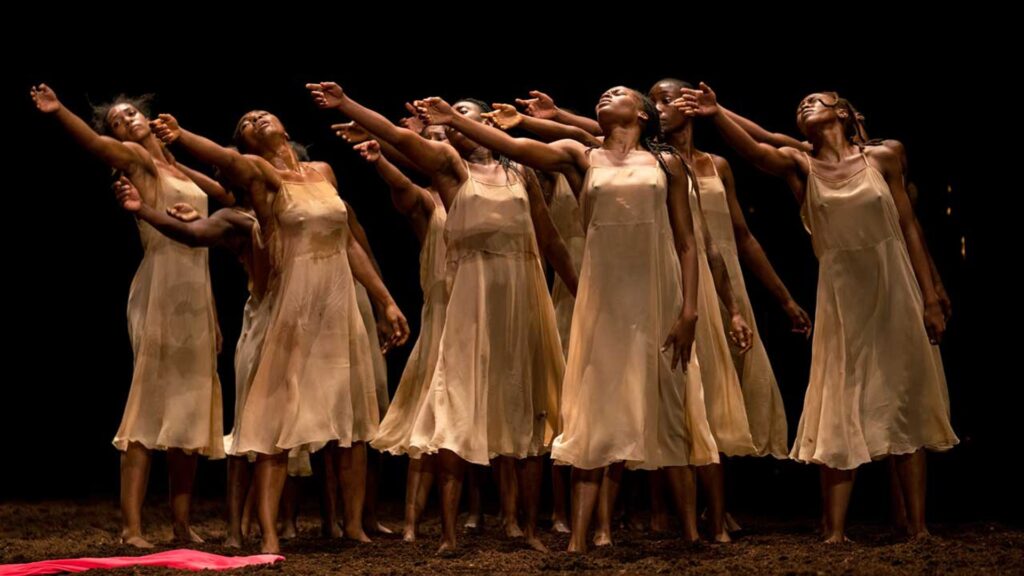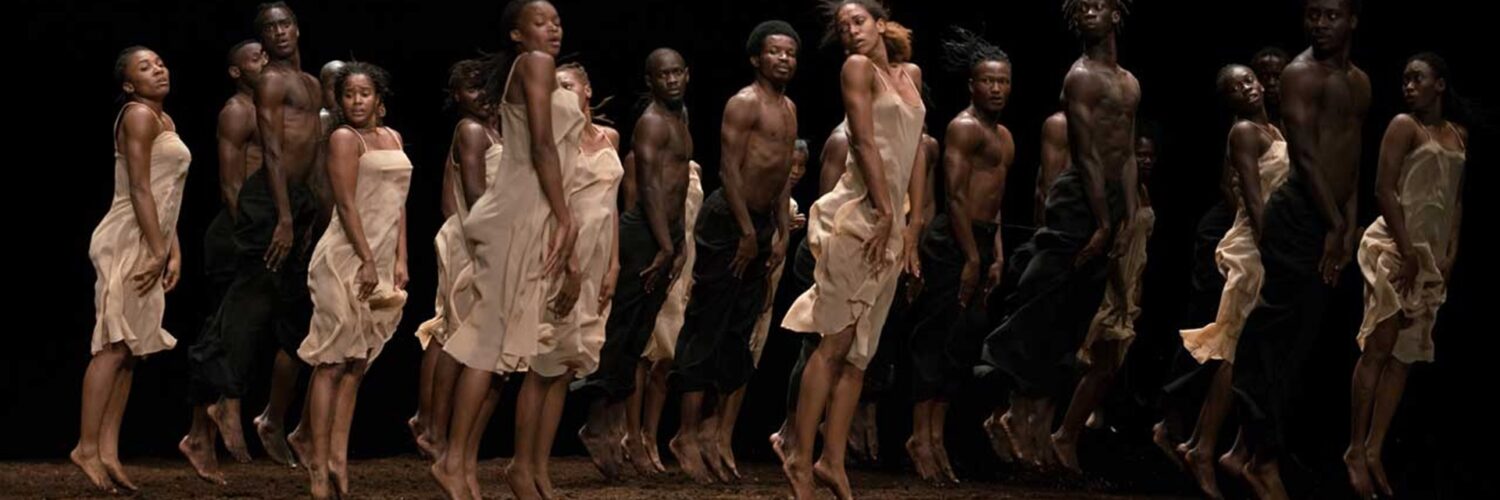
Pina Bausch’s ballet Rite of Spring was staged at The Music Center’s Dorothy Chandler Pavilion with performances over four nights, February 8-11, 2024.
More than thirty dancers from 13 African countries made history at The Music Center’s Dorothy Chandler Pavilion, interpreting the famous work as a battle of the sexes. Thrillingly, Bausch’s iconic piece was performed entirely—for the first time ever—by an African dance corps.
Production photos credit-Maarten Vanden Abeele.
Review by Brian Sonia-Wallace:
Pina Bausch is a seminal choreographer who inspired a generation of artists, and Los Angeles was treated to a rare (and brief) opportunity to see her work live. It was interpreted by Senegal’s pioneering École des Sables, gathering 38 dancers from 14 different African countries, and prefaced by a new inter-cultural collaboration entitled common ground[s]. Bausch is a choreographer interested in ritual, the way meaning blossoms and changes from repetition of action. It was a joy to see this instance of her work’s ritual.
common ground[s]
The show began with artists Germaine Acogny (“the mother of contemporary African dance”) and Malou Airaudo (a longtime Bausch dancer) in their new duet common ground[s], setting the stage for the cultural exchange at the heart of the evening. With a minimalist score by composer Fabrice Boullion LaForest, the women revolved around each other, meeting and parting and shifting roles.
It was moving to watch the interactions between this pair of older dancers, both grandmothers, their movements deft and precise. In one moment, Airaudo exposes Acogny’s back to scratch it, a small gesture that I felt in my own body. The pair are unafraid of the silliness of the body, of all its everyday capacities for things as simple as washing clothes.
Dance-as-ritual familiarizes the audience to the movement happening in front of us, as if the action is repeated onstage until it is in our bodies, too. Part of ritual is to be boring, to allow the mind to wander and enter its own meditations. As the audience coughed and wheezed through the quiet score and the performers broke their movement to speak and sing with minimal amplification, there was the sense that this was something not done for us, but rather, in our presence.
At the end of the piece, the woman next to me turned to ask, “did you get that?” It scarcely mattered; before Bausch’s pounding, insistent The Rite of Spring, this quiet duet felt like an amuse-bouche.
The Rite of Spring
No sooner had common ground[s] ended than a swarm of stagehands emerged with dirt and dirt-moving machines, and the entirety of the 30-minute intermission was its own ballet transforming the stage with fine brown earth, inches-deep. It was a scene change so vast and intense that at the end, the audience applauded.
Then Bausch’s work began in earnest, an exploration of unison and dissonance between two convulsing groups of dancers — divided into men and women — with soloists emerging from the throng to follow a single red dress on a journey through an otherwise colorless world. As they beat the freshly-laid dirt with their feet, it sprayed into the air like a fog machine and the smell of earth permeated the theatre.
Bausch’s movement plays with the line between ritual and mechanization, and once brutal and beautiful: stabbing, grasping, sawing, clutching. Individual dancers emerge, and dissolve back into the mass. There is a sense of gossip — once a movement starts, it spreads and grows like a rumor, leading the groups of dancers to coalesce, conflict, and finally dissolve.
Frenzy freezes to reveal a scene in one moment, and stillness gives way, in the next, to tremors. Always there are two groups and a lone figure, signaled out, watching and being watched by the crowd before plunging back in — a dance of voyeurism and communality.
In contrast to the darkness of the first work, during the Bausch even the lights on the audience were up almost the whole time, with the effect of making the spectators part of the show, too, a third mass of bodies to the two groups onstage. The soil, too, becomes a presence, giving the dance materiality — the stage ends transformed by feet, the dancer’s white costumes stained with dirt.
In The Rite of Spring, the dancers are all young, and the juxtaposition with common ground[s] raises questions for the audience about who is left from prior generations (Bausch herself died in 2009) and how tradition continues. “How would you dance if you knew you were going to die?” Bausch supposedly asked as the central question guiding The Rite of Spring, in which the central dancer resists and finally accepts the role of sacrifice, dancing herself to death to bring on springtime.
Part of the joy of dance is the way it resists narrative. Elder dancer Acogny says, “when I first saw Pina’s Rite of Spring, I felt it was an African rite,” and to see this German dance with African artists on an American stage feels meaningful in ways I’m still unpacking. My mind goes to Breonna Taylor and the involuntary martyrs of the Black Lives Matter movement, but also Beyonce, fierce and proud in her call to “get in formation.”
Great works of art survive because they contain something that is legible across cultures and time, and so can become the nexus of cultural exchange. Antagonism between the sexes, fear and panic, desire and sacrifice — The Rite of Spring is so pulsingly human that it feels like its story is always uniquely of our time.
More history of Stravinsky’s music and Bausch’s work can be found here.
Pina Bausch’s ballet Rite of Spring & common ground[s]
The Music Center’s Dorothy Chandler Pavilion
Performances:
Thursday, February 8, 2024, 7:30 p.m.
Friday, February 9, 2024, 7:30 p.m.
Saturday, February 10, 2024, 7:30 p.m.
Sunday, February 11, 2024, 2:00 p.m.
In person – Box Office–(213) 972-0711. Open Tuesday – Saturday, 10:00 a.m. – 6:00 p.m.
Interested in bringing a group to this performance? Learn more about group bookings.
Programs, dates & artists subject to change.





